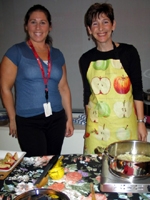
Lynn Goldstein (left) and Rebecca Katz demonstrate how to fix a healthy, delicious meal.
Just in time for fall, a cooking demonstration on September 14 at the Jay Monahan Center for Gastrointestinal Health served up dietary advice and delicious samples of nutritious fare for the new season.
Lynn Goldstein, a registered dietician at the Monahan Center, opened with a discussion of how to maximize one's nutritional health during the fall season. To make her advice pleasantly palatable, community members in the audience received a medley of nuts, roasted pumpkin seeds, sweet apples with natural peanut butter, and dried berries, picked at their freshest and then preserved.
Wise, informed dietary choices, together with exercise and healthy weight, could prevent three to four million cancer cases worldwide each year, Ms. Goldstein said. An astounding three out of four cases of colorectal cancer can be kept at bay with a healthy diet.
Our nation's culinary profile is sliding into the danger zone, she added. On any given day, Americans consume 815 billion calories — largely derived from hot dogs, bacon, red meat and eggs, sweets and liquor.
The culprit behind the bingeing, Ms. Goldstein said, is America's fondness for dining out — whether heading to a restaurant or grabbing meals from fast-food chains or vending machines. These meals are often astoundingly high in fat and calories and low on fiber, vitamins and minerals.
In a bid to overhaul the dietary habits of Americans, the American Journal of Clinical Nutrition released a proposed new food pyramid, which Ms. Goldstein handed out. The guidelines advocate daily exercise; abundant whole-grain foods, plant oils, vegetables and fruits; limited servings of fish, poultry, eggs and dairy; and sparing consumption of red meat, butter, and refined, processed carbohydrates like white rice, potatoes, pasta and sweets. Alcohol is fine in moderation, and multiple-vitamin supplements are recommended, though Ms. Goldstein added that natural sources of vitamins are always preferred.
Ms. Goldstein highlighted the importance of a plant-based diet, rich in whole grains, legumes, roots and tubers. A rich variety of foods falls within these categories, including sweet potatoes and squash — both at their apex in the fall. Brown rice is a good bet, but to introduce variety and banish boredom, explore the taste of its "cousin" grains like barley, millet and quinoa. Choose bean and soy protein sources first; otherwise choose lean meat, fish and poultry.
She also recommended fruits and vegetables with all meals and snacks. Canned and frozen produce, picked at its peak, locks in nutrients and are just as good as the fresh variety. The different colors in vegetables (like green, orange, red, yellow) are evidence of various antioxidants and phytochemicals, each of which confers health benefits. To reap them all, "eat a rainbow of fruits and vegetables every day," she advised.
While everyone needs fat, it should be unsaturated variety. "Avoid trans fatty acids whenever possible," she said. This fat is encoded in the label "partially hydrogenated" found in margarine, cookies and crackers.
Finally, she endorsed fiber as a possible protective source from some forms of cancer. We should aim to consume 25 to 30 grams of fiber daily; its richest sources are unprocessed whole-grain foods, fruits and vegetables, lentils and beans, and flaxseed.
Rebecca Katz, author of "One Bite at a Time: Nourishing Recipes for People with Cancer, Survivors, and Their Caregivers" whipped up some hearty soup that translated Goldstein's advice into gustatory delight. Cooking on a burner, she built a delicious soup around healthy fats, plant sources and nutritious veggies: carrot-ginger soup with cashew cream.
"This is proof that good nutrition and great taste don't have to sit at opposite sides of the table," she said.
Ms. Katz employed some culinary alchemy, guided by the acronym FASS — fat (healthy versions like olive oil and cashews); acid (from citrus fruits like lemons and limes); sea salt (just a pinch); and sweet (not refined sugar, but organic maple syrup).
"These flavor carriers bring out the natural flavors in nutritious foods," she explained. "Fat is like a magic carpet that transverses your taste buds." Acid brightens food, with a dash of antioxidants for good measure; salt wakes up the taste buds and sweetness rounds out flavor.
The goal, she said, is to activate the tongue's "yum button" — her term for the "involuntary spasm of vocal delight" that comes upon tasting something sublime.
Ms. Katz first sautéed onions in sea salt, which is not bleached of minerals like many other salts. Salt helps release the onion's flavors, coaxing out the sweetness. She added spices like curry powder, cumin and cinnamon to create a flavor seal, as the spices mingled with the onions. She poured in boiled carrots, the broth gathered from the boil, and grated ginger. She then emulsified the mixture in a blender, and poured the puree back into the pan and worked the FASS magic with another pinch of salt, lemon juice and maple syrup. The finishing dollop of cashew cream made for a butter-flavored, show-stopping finale that's a great dairy substitute.
The soup has the added virtue of freezing well, she said. And carrots are only one possible base. Cooks can rotate in a whole roster of vegetables to steal the spotlight: sweet potato, winter squash, roasted asparagus, spinach.
The seminar represented part of the Monahan mission to provide resources and community outreach to promote health and wellness in the treatment and prevention of cancers.
Carrot-Ginger Soup with Cashew Cream
Adapted from "One Bite at a Time: Nourishing Recipes for People with Cancer, Survivors, and Their Caregivers," by Rebecca Katz with Marsha Tomassi and Mat Edelson
SOUP
3 pounds carrots washed and cut into 1-inch pieces
8-10 cups cold water
1 tsp. sea salt
3 tbsp. extra virgin olive oil
2 cups chopped yellow onions
2 tsps. grated fresh ginger
1/2 tsp. curry powder
1/4 tsp. ground cumin
1/8 tsp. ground cinnamon
1/8 tsp. ground allspice
1/8 tsp. ground coriander
1 small pinch of red pepper flakes
1/8 tsp. maple syrup
CASHEW CREAM
1 cup raw cashews
1 cup water
1 1/2 tbsp. fresh lemon juice
1/2 tsp. sea salt
Pinch of freshly grated nutmeg
To make the soup, combine the carrots and water in a 6- to 8-quart pot. Cover and bring to a boil over medium-high heat. Add the one teaspoon of salt and decrease the heat to medium-low. Cook until the carrots are very tender, about 20 minutes. Drain, reserving the cooking liquid and carrots in two separate bowls.
In the same pot, heat the olive oil over medium heat. Add the onions with a pinch of salt and saute until golden. Add the ginger, curry, cinnamon, allspice, coriander, and red pepper flakes and stir to combine. Deglaze the pan with one cup of carrot cooking liquid. Add the carrots to the pot and mix well to coat with the onions and spices.
In a blender, puree the soup in batches, adding the cooking liquid first and then the carrots. Blend until very smooth. Add additional liquid to reach the desired thickness. Return to the pot, add the maple syrup, and reheat slowly. Think FASS and taste. Does it need a squeeze of lemon, a pinch or two of salt, or a drizzle of maple syrup?
To make the cashew cream, grind the cashews in a mini food processor or nut grinder. Put the water into a blender. Add the ground cashews, lemon juice, salt, and nutmeg. Blend until very smooth, about three minutes. To serve, ladle the soup into bowls and drizzle cashew cream on top.
Photo by Melissa Hantman.

